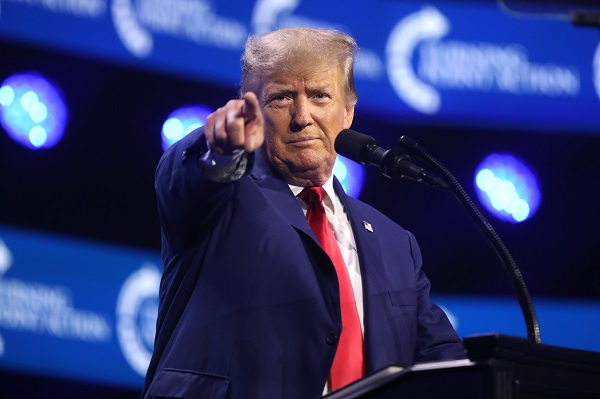Uncategorized
Trump’s ‘Drill, Baby, Drill’ Agenda Will Likely Take On An Entirely New Shape


From the Daily Caller News Foundation
By David Blackmon
During his campaign and since taking office, President Donald Trump often repeated his desire to bring back the same “drill, baby, drill” oil and gas agenda that characterized his first term in office.
But that term began 8 long years ago and much has changed in the domestic oil business since then. Current market realities are likely to mitigate the industry’s response to Trump’s easing of the Biden administration’s efforts to restrict its activities.
Trump’s second term begins as the upstream segment of the industry has enjoyed three years of strong profitability and overall production growth by employing a strategy of capital discipline, technology deployment and the capture of economies of scale in the nation’s big shale play areas. Companies like, say, ExxonMobil and Oxy and their peers are unlikely to respond to the easing of government regulations by discarding these strategies that have brought such financial success in favor of moving into a new drilling boom.
This bias in favor of maintenance of the status quo is especially likely given that the big shale plays in the Permian Basin, Eagle Ford Shale, Bakken Shale, Haynesville and the Marcellus/Utica region have all advanced into the long-term development phases of the natural life cycle typical of every oil and gas resource play over the past 175 years. Absent the discovery of major new shale or other types of oil-or-natural gas-bearing formations, a new drilling boom seems quite unlikely under any circumstances.
One market factor that could result in a somewhat higher active rig count would be a sudden rise in crude oil prices, if it appears likely to last for a long period of time. Companies like Exxon, Chevron, Oxy and Diamondback Energy certainly have the capability to quickly activate a significant number of additional rigs to take advantage of long-term higher prices.
But crude prices are set on a global market, and that market has appeared over-supplied in recent months with little reason to believe the supply/demand equation will change significantly in the near future. Indeed, the OPEC+ cartel has been forced to postpone planned production increases several times over the past 12 months as an over-supplied market has caused prices to hover well below the group’s target price.
But it is wrong to think the domestic oil industry will not respond in any way to Trump’s efforts to remove Biden’s artificial roadblocks to energy progress. Trump’s efforts to speed up permitting for energy projects of all kinds are likely to result in a significant build-out of much-needed new natural gas pipeline capacity, natural gas power generation plants and new LNG export terminals and supporting infrastructure.
Instead of another four years of “drill, baby, drill,” the Trump efforts to speed energy development seem certain to result in four years of a “build, baby, build” boom.
Indeed, the industry is already responding in a big way in the LNG export sector of the business. During Trump’s first week in office, LNG exporter Venture Global launched what is the largest energy IPO by value in U.S. history, going public with a total market cap of $65 billion.
With five separate export projects currently in various stages of development, all in South Louisiana, Venture Global plans to become a major player in one of America’s major growth industries in the coming years. Trump’s Day 1 reversal of Biden’s senseless permitting pause on LNG infrastructure is likely to kick of a number of additional LNG projects by other operators.
The Trump effect took hold even before he took office when the Alaska Gasline Development Corporation entered into an exclusive agreement in early January with developer Glenfarne to advance the $44 billion Alaska LNG project. The aim is to start to deliver gas in 2031, with LNG exports following shortly thereafter.
America’s oil and gas industry has demonstrated it can consistently grow overall production to new records even with a falling rig count in recent years. Now it must grow its related infrastructure to account for the rising production.
That’s why Trump’s “drill, baby, drill” mantra is likely to transform into “build, baby, build” in the months and years to come.
David Blackmon is an energy writer and consultant based in Texas. He spent 40 years in the oil and gas business, where he specialized in public policy and communications.
Uncategorized
Cost of bureaucracy balloons 80 per cent in 10 years: Public Accounts

The cost of the bureaucracy increased by $6 billion last year, according to newly released numbers in Public Accounts disclosures. The Canadian Taxpayers Federation is calling on Prime Minister Mark Carney to immediately shrink the bureaucracy.
“The Public Accounts show the cost of the federal bureaucracy is out of control,” said Franco Terrazzano, CTF Federal Director. “Tinkering around the edges won’t cut it, Carney needs to take urgent action to shrink the bloated federal bureaucracy.”
The federal bureaucracy cost taxpayers $71.4 billion in 2024-25, according to the Public Accounts. The cost of the federal bureaucracy increased by $6 billion, or more than nine per cent, over the last year.
The federal bureaucracy cost taxpayers $39.6 billion in 2015-16, according to the Public Accounts. That means the cost of the federal bureaucracy increased 80 per cent over the last 10 years. The government added 99,000 extra bureaucrats between 2015-16 and 2024-25.
Half of Canadians say federal services have gotten worse since 2016, despite the massive increase in the federal bureaucracy, according to a Leger poll.
Not only has the size of the bureaucracy increased, the cost of consultants, contractors and outsourcing has increased as well. The government spent $23.1 billion on “professional and special services” last year, according to the Public Accounts. That’s an 11 per cent increase over the previous year. The government’s spending on professional and special services more than doubled since 2015-16.
“Taxpayers should not be paying way more for in-house government bureaucrats and way more for outside help,” Terrazzano said. “Mere promises to find minor savings in the federal bureaucracy won’t fix Canada’s finances.
“Taxpayers need Carney to take urgent action and significantly cut the number of bureaucrats now.”
Table: Cost of bureaucracy and professional and special services, Public Accounts
| Year | Bureaucracy | Professional and special services |
|
$71,369,677,000 |
$23,145,218,000 |
|
|
$65,326,643,000 |
$20,771,477,000 |
|
|
$56,467,851,000 |
$18,591,373,000 |
|
|
$60,676,243,000 |
$17,511,078,000 |
|
|
$52,984,272,000 |
$14,720,455,000 |
|
|
$46,349,166,000 |
$13,334,341,000 |
|
|
$46,131,628,000 |
$12,940,395,000 |
|
|
$45,262,821,000 |
$12,950,619,000 |
|
|
$38,909,594,000 |
$11,910,257,000 |
|
|
$39,616,656,000 |
$11,082,974,000 |
Uncategorized
Trump Admin Establishing Council To Make Buildings Beautiful Again


From the Daily Caller News Foundation
By Jason Hopkins
The Trump administration is creating a first-of-its-kind task force aimed at ushering in a new “Golden Age” of beautiful infrastructure across the U.S.
The Department of Transportation (DOT) will announce the establishment of the Beautifying Transportation Infrastructure Council (BTIC) on Thursday, the Daily Caller News Foundation exclusively learned. The BTIC seeks to advise Transportation Secretary Sean Duffy on design and policy ideas for key infrastructure projects, including highways, bridges and transit hubs.
“What happened to our country’s proud tradition of building great, big, beautiful things?” Duffy said in a statement shared with the DCNF. “It’s time the design for America’s latest infrastructure projects reflects our nation’s strength, pride, and promise.”
“We’re engaging the best and brightest minds in architectural design and engineering to make beautiful structures that move you and bring about a new Golden Age of Transportation,” Duffy continued.
Mini scoop – here is the DOT’s rollout of its Beautifying Transportation Infrastructure Council, which will be tasked with making our buildings beautiful again. pic.twitter.com/
9iV2xSxdJM — Jason Hopkins (@jasonhopkinsdc) October 23, 2025
The DOT is encouraging nominations of the country’s best architects, urban planners, artists and others to serve on the council, according to the department. While ensuring that efficiency and safety remain a top priority, the BTIC will provide guidance on projects that “enhance” public areas and develop aesthetic performance metrics.
The new council aligns with an executive order signed by President Donald Trump in August 2025 regarding infrastructure. The “Making Federal Architecture Beautiful Again” order calls for federal public buildings in the country to “respect regional architectural heritage” and aims to prevent federal construction projects from using modernist and brutalist architecture styles, instead returning to a classical style.
“The Founders, in line with great societies before them, attached great importance to Federal civic architecture,” Trump’s order stated. “They wanted America’s public buildings to inspire the American people and encourage civic virtue.”
“President George Washington and Secretary of State Thomas Jefferson consciously modeled the most important buildings in Washington, D.C., on the classical architecture of ancient Athens and Rome,” the order continued. “Because of their proven ability to meet these requirements, classical and traditional architecture are preferred modes of architectural design.”
The DOT invested millions in major infrastructure projects since Trump’s return to the White House. Duffy announced in August a $43 million transformation initiative of the New York Penn Station in New York City and in September unveiledmajor progress in the rehabilitation and modernization of Washington Union Station in Washington, D.C.
The BTIC will comprise up to 11 members who will serve two-year terms, with the chance to be reappointed, according to the DOT. The task force will meet biannually. The deadline for nominations will end Nov. 21.
-

 Digital ID15 hours ago
Digital ID15 hours agoCanada releases new digital ID app for personal documents despite privacy concerns
-

 Business1 day ago
Business1 day agoMajor tax changes in 2026: Report
-

 International24 hours ago
International24 hours agoRussia Now Open To Ukraine Joining EU, Officials Briefed On Peace Deal Say
-

 Censorship Industrial Complex24 hours ago
Censorship Industrial Complex24 hours agoDeath by a thousand clicks – government censorship of Canada’s internet
-

 Energy14 hours ago
Energy14 hours agoCanada’s sudden rediscovery of energy ambition has been greeted with a familiar charge: hypocrisy
-

 Alberta1 day ago
Alberta1 day agoSchools should go back to basics to mitigate effects of AI
-

 Daily Caller1 day ago
Daily Caller1 day agoChinese Billionaire Tried To Build US-Born Baby Empire As Overseas Elites Turn To American Surrogates
-

 Daily Caller1 day ago
Daily Caller1 day agoTwo states designate Muslim group as terrorist










